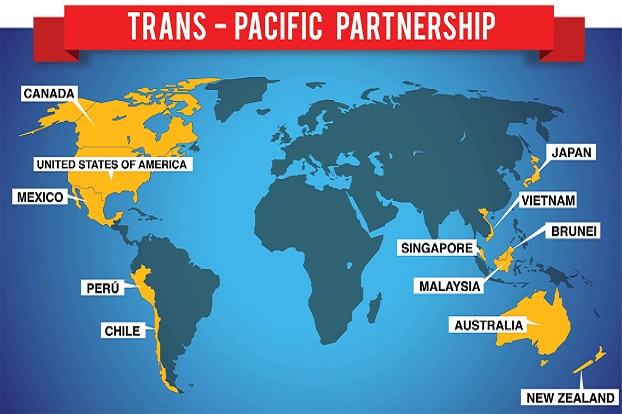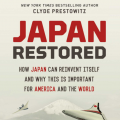Nowadays the realization of the Trans-Pacific Partnership (TPP) seems to be a likely scenario. On October 5, the interminable negotiations between the representatives of the twelve nations that will be part of the historical trade agreement were completed. After one month, it was released for the first time to the public the full version of the agreement, that in the years of its formation was kept secret to give more autonomy to negotiators. In this regard, critics say the process of drafting the TPP is deeply flawed since negotiations were conducted in secret, with well-connected interest groups having access to more information — and more opportunities to influence the process — than members of the general public.
The content was published online at the beginning of November and consists of more than five thousand pages organized in thirty chapters.
The beginnings
The origin of the TPP date back to 2006, when Singapore, the Sultanate of Brunei, Chile and New Zealand put in place an economic and strategic partnership. Only two years later the USA, Australia and Peru made explicit request to start a negotiation on free trade with these countries. Later on, in 2010, Malaysia and Vietnam entered the agreement, followed by Mexico and Canada in 2012. Lastly, Japan acceded the TPP in 2013.
It took more than five years of negotiations to form the body of the agreement. During that time nineteen institutional meetings were held in the major cities of the Pacific Rim.
Today, significant obstacles remain to finalize the approval of the TPP. Each of the twelve States will have to proceed with a legal review of the agreement and then proceed to its approval and subsequent ratification. Among the major threats to the realization of the TPP there are undoubtedly the intricate political and strategic interests. The geopolitical value of the TPP is immeasurable. The TPP will affect twelve nations that represent approximately 40% of global GDP.
The image below shows the magnitude of the TPP, focusing on volumes of goods traded between the USA and the other eleven nations of the Agreement.

What is the TPP?
The Trans-Pacific Partnership is a trade agreement among countries bordering the Pacific Ocean.
The TPP is expected to reduce trade barriers among these countries, lowering tariffs on goods.
But it will do a lot of other things, too. The agreement could require countries to adopt stricter labor and environmental rules, provide stronger legal protections to drug companies, lengthen the term of copyright protection, give foreign investors a new way to challenge countries’ laws and regulations, and much more.
In short, modern trade deals like the TPP are about a lot more than just trade. They’ve become one of the major ways the world hashes out the rules of the global economy. And that’s a big reason the deal has become controversial. For example, digital rights groups and global health advocates who are not normally focused on trade issues have warned that the deal could negatively impact digital innovation and the global effort to combat AIDS, among other things.
The participants and the main implications of the agreement
In the United States President Obama is strongly pursuing the approval process of the TPP, wishing to leave to the country a new political and commercial landscape. According to Obama’s vision it should be a starting point to reinforce commercially the country and to limit the ongoing economic expansion of China.
In the USA the debate is vibrant. The battleground on which Obama will play is hostile because of the presidential elections that will take place in the next November. Democrats and Republicans -represented respectively by Mrs. Clinton and Mr. Trump – are hindering the TPP with harsh criticism and this won’t certainly facilitate the approval of the agreement by the Congress.
The opponents of the TPP focus their disappointment on those that would be plausible negative effects of the agreement on the labor market, either in terms of employment level or wage level.
At the business level, the tobacco industry is one of the fields on which Obama risks to lose more. Why? Final TPP agreement allows countries to ban tobacco companies from using the ad hoc private tribunals, as wanted by the Investor-state dispute settlement (ISDS).
In a nutshell, the Investor-state dispute settlement (ISDS) is an instrument of public international law, that grants an investor the right to use dispute settlement proceedings against a foreign government. Provisions for ISDS are contained in a number of bilateral investment treaties and in certain international trade treaties. If an investor from one country (the “Home State”) invests in another country (the “Host State”), both of which have agreed to ISDS, and the Host State violates the rights granted to the investor under public international law, then that investor may bring the matter before an arbitral tribunal. Except for tobacco companies, the right to make use of the ISDS will instead be available to all the other industries involved in the treaty. Thus, as said on December 3 by Dave Reichert, the chairman of the House Ways & Means trade subcommittee, roughly 15 House Republicans would oppose TPP over its treatment of tobacco.
The Republicans have also spoken out against other hot topics regarding different industries within the American economy. Among them, the pharmaceutical sector has caused a heated debate. Few other arguments in the course of the long negotiations for the formulation of the TPP have generated such controversy. Even the difficult chapter on intellectual property hasn’t been so much discussed.
The stakes are very high in the field of pharmaceutical products. For this reason, the pharmaceutical industry has lobbied hard for rules that would limit competition in the drug market, arguing that stronger protections were needed to allow drug companies to finance research and development. Those provisions have raised the ire of public health groups, which say that making drugs more expensive will deny millions of people access to potentially lifesaving medicine.
There are two specific ways the TPP would make drugs more expensive and inaccessible
First, by allowing companies easier access to patent extensions for medicines. In fact, TPP mandates that governments consider extending patent terms beyond the usual 20-year term
Second, through new data exclusivity protections for biologic drugs
The question of how long companies can keep this data secret, particularly with respect to biologic drugs, was one of the major sticking points in the negotiations.
Biologics are more difficult and expensive to make, costing on average 22 times more than non-biologic drugs. Because of the high prices of these drugs, companies are very interested in developing “biosimilars” — cheaper copies of the original drugs. The reason behind it consists in the fact that manufacturers can usually just rely on data from clinical trials submitted by the maker of the original biologic. To prevent this, US law gives the maker of a biologic drug 12 years of data exclusivity. By contrast, in other countries, there are looser rules – or no rules – around such data exclusivity. Japan offers eight years, for instance. Brunei offers zero.
The United States (and big pharmaceutical companies) had been pushing to get every country to agree on 12 years of data protection for biologics. The final agreement didn’t go that far: Biologics data will be protected for at least five, and in some cases at least eight, years.
Eventually, the Republicans were not satisfied about the final decision, and so they decided to
take the defenses of the pharmaceutical companies.
Going back to the ISDS as a means of resolving disputes it should be added that it is a tool that if on the one hand certifies its effectiveness in protecting investments, on the other hand it entails a risk to any State in the defense of its own sovereignty. In the case of the USA, Senator Elizabeth Warren, one of the major opponent of the TPP, has stressed many times that it would undermine U.S. sovereignty. However, the White House reassures that implementation of the ISDS will be closely followed by the authorities to prevent future abuses on it.
Another hot topic concerns the exchange and the flows of big-data, which are becoming increasingly worthy among businesses, from telecommunications to financial services. One of the most discussed fact is that TPP does not ban governments from imposing requirements that financial services companies store data on servers within their territory. This omission has raised the ire of U.S. financial services firms. Overall, TPP is criticized as it would inexorably facilitate the major economic players in the US, such as the multinationals, the powerful companies located in Silicon Valley, the banks and Wall Street.
In June, President Obama convinced Congress to pass legislation to grant him “fast track” authority, which guarantees that the TPP will get a prompt up-or-down vote in Congress. Now he needs to convince a majority in Congress to approve the TPP itself. That vote is expected to happen in the first half of 2016.
The current exclusion of China from TPP would open up great opportunities for adjoining countries that until now have been squeezed by Chinese industrial leadership.
Vietnam, whose low-wage economy relies on exports, is likely to be the biggest winner of the Trans-Pacific Partnership that slashes an estimated 18,000 tariffs among the dozen participating countries. Reduced import duties will benefit the country’s apparel manufacturers, whose low labor costs have enabled them to grab business from China. Nowadays Vietnam hosts a considerable number of big players operating within the fashion industry. Vietnam may have a 50 percent increase in apparel and footwear exports in 10 years.
Further considerations should be pointed out regarding the agricultural sector. In fact, in Vietnam about half of the population works in agriculture. The export level of the food industry has reached a huge size (over thirty billion dollars in 2014) and the demand of food products from the rest of the world is nowadays increasing. Said that, it is a clear consequence that the strict TPP rules regarding the environment and the working laws will bring considerable threats and opportunity for the whole sector.
The more optimistic experts believe that the benefits due to an improvement of the agricultural technology (thanks to greater investment) will exceed the costs that the country will have to pay to meet the standards. Overall, from a simulation made by the World Bank it has come out an expected increase of the GDP by 8%.
The gradual and substantial rise of the labour cost in China is granting vital space to the Vietnamese industry. However, among the biggest challenges for Vietnam there will be the regulation of the labour market that will have to comply with the strict deadlines agreed upon by the parties along the negotiations.
Beside Vietnam, the Latin countries such as Mexico, Chile and Peru will leverage TPP. Chile and Peru could obtain a more agile access to the American market and exploit their status of large producers of commodities. Mexico could benefit from the trade agreement even more than the two aforementioned South American countries. Its already intense integration with Canada and USA and the prospects of a more open trade with other member States such as Australia, New Zealand, Brunei and Vietnam, open up enormous commercial opportunities to the country.
The labour market remains a critical point. TPP opponents argue that likely the treaty will pull down the average wages due to the increased competition. In this regard, opponents expect an increasing trend of offshoring toward other low cost production countries. However, according to the words of the Mexican President Nieto, the TPP will stimulate both investments and a greater offer of well paid work for his people. For these reasons, Mexico has adopted a constructive line in drafting the agreement, confident of the future development and exploitation of key sectors of the economy such as the aerospace industry. A Mexican expansion in Asia could greatly broaden the business scenario of the country. Nowadays only one out of forty free trade agreements that Mexico has put in place is with an Asian country: Japan.
With regard to Japan, the Premier Abe has been trying to regain popularity by promoting the need for the country to play its role in the geopolitical dynamic triggered by the TPP. Abe aims to accelerate the systemic reforms initiated in the past. The primary objective would be to grant to Japan and its economic sectors greater access to foreign markets. Domestic consumption decline pushes the Abenomics to a broader opening of national borders to expand trade relations with foreign countries. Based on these considerations, although Japan will meet several obstacles and difficulties, as in the context of agriculture, the prime minister will try to complete the ratification process of the TPP.
Canada is another relevant player of the agreement. An advantage for the country would derive from the liberalisation on investments promoted by the TPP. Thus, Canadian investments towards the other member countries would be fairly treated and would receive a non-discriminatory treatment.
As well as Canada, also the other eleven countries would have a greater access to the foreign markets and the possibility to launch protected investment. This would notably change the world trade flows and the geographical distribution of investments.
The Chinese dilemma
In the previous paragraphs it has already been stated that the accession to the TPP is open to other countries willing to enter it.
Reportedly China has been invited by the USA to take part to the TPP. Of course, the invitation is not a courtesy invitation. The relationship between the first two world powers are tense due to the strategic and geopolitical interests floating around the TPP and other political topics.
The TPP, on top of encouraging trade flows, imposes to participating countries the respect of several standards. Thus, it seems that Washington, calling Beijing to become part of the agreement, desire in the long term to relegate China in a rule-based economic system.
China is skeptical in evaluating the proposal regarding the TPP.
The mere fact that Japan will be one of the most influential actors of TPP has strongly disturbed Chinese politicians and experts in trade. Nowadays, Japan is still a political and military rival for China. The TPP would guarantee to Japan the access to the American market, especially in high technological sectors, such as the automotive and telecommunications. Precisely where China is trying to reach a leadership position.
Once made these considerations, it should however be emphasized that the contemplation of China on its possible entry in the TPP is to be considered as a huge success. Why?
Because the TPP will touch critical topics for Beijing. The TPP is the first commercial agreement all over the world to discuss the environmental protection theme and the settlement of health standards. The agreement contains also specific provisions on labor rules and other sensitive issues such as gender equality.
Furthermore, in assessing the prospects for its entry China tells the world that is ready to face the challenges with respect to State owned enterprises.
Meditating the the access to the TPP China indirectly indicates to be ready to face such politically sensitive issues, in order to prevent the loss of political and commercial power in case of approval of the TPP.
Which other countries are evaluating the TTP membership?
Indonesia is among the countries that would later take part to the TTP, with its one trillion dollars GDP. If it were to become part of the pool of nations constituting the treaty, it would be the fourth largest economy to join it.
Nevertheless, to secure the entrance, Indonesia is called to free the private sector by removing many barriers that were erected over years pursuing a policy based on protectionism. Furthermore, internal bureaucracy should be reduced. Another hot topic is corruption, that over the years has hindered the domestic economy. According to Indonesian politicians it comes to a minimum of two years before they can think of being part of the TPP. A complicating matter is the fact that President Widodo has a narrow parliamentary base that essentially hinder the process of access to the treaty. Despite the aforementioned considerations, the support of the President Widodo represents itself a political victory for Obama.
In addition to Indonesia, the Philippines and Thailand have declared their intention to join the treaty. As established by the US, the TPP is an open treaty that can be joined by other nations once provided that the agreed standards are met.
About the potential entry of Thailand, several studies have shown that the country could benefit enormously from its accession.
The Philippines publicly declared their interest in joining the TPP. Also in this case, however, considerable complications could slow down its accession. For instance, either the presence of state-owned companies or the actual limitations to foreign companies with respect to certain sectors clash with the guidelines to be met in order to access the TPP. Thus, it would be also necessary to amend some parts of the Constitution. To do that, however, the actual government does not seem to have the necessary votes. Compared to the Philippines, Thailand is better equipped to join the TPP. The point is that the national political instability within the country is too pronounced to make political forces be focused on TPP.
In an even more solid position to access the TPP there is South Korea. Most of South Korean companies would seem to push Seoul to join the treaty. However, Korea appears to be a strategic partner desired by most of the world powers, especially by US, Russia and China. The American interest towards South Korea is both strategic and commercial. China is South Korea’s largest trading partner and in addition to the weight of trade relations, there is a kind of geopolitical interest in South Korea. Thanks to its geographic location, Beijing is able to control North Korea.
The North Korean supreme leader Kim Jong-Un is increasingly a threat in Southeast Asia, and that’s why China aims to constantly monitor his actions.




















Lascia un commento